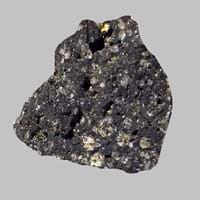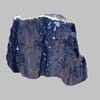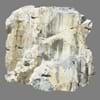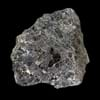Tuff and Borolanite
Definition
Definition
Tuff is a type of rock made of volcanic ash ejected from a vent during a volcanic eruption
Borolanite is a variety of Nepheline Syenite and belongs to igneous rocks and contains nepheline-alkali feldspar pseudomorphs which occur as conspicuous white spots in the dark rock matrix
History
Origin
Italy
Scotland
Discoverer
Unknown
Unknown
Etymology
From a Latin word tophous then in Italian tufo and finally tuff
From Alkalic Igneous complex near Loch Borralan in northwest Scotland
Class
Igneous Rocks
Igneous Rocks
Sub-Class
Durable Rock, Medium Hardness Rock
Durable Rock, Medium Hardness Rock
Family
Group
Volcanic
Plutonic
Other Categories
Fine Grained Rock, Opaque Rock
Fine Grained Rock, Opaque Rock
Texture
Texture
Clastic, Pyroclastic
Granular
Color
Brown, Grey, Yellow
Brown, Buff, Cream, Green, Grey, Pink, White
Maintenance
More
Less
Durability
Durable
Durable
Water Resistant
Yes
Yes
Scratch Resistant
Yes
No
Stain Resistant
No
No
Wind Resistant
No
Yes
Acid Resistant
No
Yes
Appearance
Dull, Vesicular and Foilated
Banded and Foilated
Uses
Architecture
Interior Uses
Decorative Aggregates, Entryways, Flooring, Homes, Interior Decoration
Countertops, Decorative Aggregates, Flooring, Homes, Interior Decoration
Exterior Uses
As Building Stone, As Facing Stone, Garden Decoration, Office Buildings, Paving Stone
As Building Stone, As Facing Stone, Paving Stone, Garden Decoration, Office Buildings
Other Architectural Uses
Curbing
Curbing
Industry
Construction Industry
Building houses or walls, Construction Aggregate
As Dimension Stone, Cement Manufacture, Construction Aggregate, for Road Aggregate, Landscaping, Making natural cement, Manufacture of Magnesium and Dolomite Refractories, Production of Glass and Ceramics
Medical Industry
Not Yet Used
Not Yet Used
Antiquity Uses
Artifacts, Monuments, Sculpture, Small Figurines
Artifacts
Other Uses
Commercial Uses
Creating Artwork
Cemetery Markers
Types
Types
Welded tuff, Rhyolitic tuff, Basaltic tuff, Trachyte tuff, Andesitic tuff and Ignimbrite.
Not Available
Features
Always found as volcanic pipes over deep continental crust
Application of acids on the surface causes cloudy frosting, Available in Lots of Colors and Patterns, Dissolves in hydrochloric acid, Is one of the oldest rock
Archaeological Significance
Monuments
Used
Used
Famous Monuments
Easter Island in the Polynesian Triangle, Pacific Ocean
Data Not Available
Sculpture
Used
Used
Famous Sculptures
Data Not Available
Data Not Available
Pictographs
Used
Used
Petroglyphs
Used
Used
Figurines
Used
Used
Fossils
Absent
Absent
Formation
Formation
Tuff is formed when large masses of ash and sand which are mixed with hot gases are ejected by a volcano and avalanche rapidly down its slopes.
Borolanites are formed due to alkaline igneous activities and are generally formed in thick continental crustal areas or in Cordilleran subduction zones.
Composition
Mineral Content
Calcite, Chlorite
Albite, Amphibole, Biotite, Cancrinite, Feldspar, Hornblende, Plagioclase, Pyroxene, Sodalite
Compound Content
Hydrogen Sulfide, Sulfur Dioxide
Aluminium Oxide, CaO, Iron(III) Oxide, FeO, Potassium Oxide, MgO, MnO, Sodium Oxide, Phosphorus Pentoxide, Silicon Dioxide, Titanium Dioxide
Transformation
Metamorphism
Yes
Yes
Types of Metamorphism
Burial Metamorphism, Cataclastic Metamorphism, Contact Metamorphism, Hydrothermal Metamorphism, Impact Metamorphism, Regional Metamorphism
Regional Metamorphism
Weathering
Yes
Yes
Types of Weathering
Biological Weathering, Chemical Weathering, Mechanical Weathering
Chemical Weathering, Mechanical Weathering
Erosion
Yes
Yes
Types of Erosion
Chemical Erosion, Coastal Erosion, Glacier Erosion, Sea Erosion, Water Erosion, Wind Erosion
Wind Erosion
Properties
Physical Properties
Hardness
4-6
5.5-6
Grain Size
Fine Grained
Fine Grained
Fracture
Uneven
Conchoidal to Uneven
Streak
White
White
Porosity
Highly Porous
Less Porous
Luster
Vitreous to Dull
Greasy to Dull
Compressive Strength
243.80 N/mm2
5
150.00 N/mm2
14
Cleavage
Not Available
Poor
Toughness
Not Available
Not Available
Specific Gravity
2.73
2.6
Transparency
Opaque
Translucent to Opaque
Density
1-1.8 g/cm3
2.6 g/cm3
Thermal Properties
Specific Heat Capacity
0.20 kJ/Kg K
25
Not Available
Resistance
Heat Resistant, Impact Resistant, Pressure Resistant, Wear Resistant
Heat Resistant, Impact Resistant, Wear Resistant
Reserves
Deposits in Eastern Continents
Asia
Afghanistan, Armenia, Azerbaijan, Burma, Cambodia, China, India, Indonesia, Iran, Japan, Malaysia, Mongolia, Nepal, North Korea, Pakistan, Saudi Arabia, Syria, Taiwan, Thailand, Turkey, Vietnam, Yemen
Indonesia, Iran, Russia, Saudi Arabia, Sri Lanka, Taiwan, Thailand, Turkey, Turkmenistan, Vietnam
Africa
Cameroon, Cape Verde, Eritrea, Ethiopia, Kenya, Libya, Madagascar, Nigeria, Rwanda, South Africa, Sudan, Uganda
Angola, Egypt, Madagascar, Namibia, Nigeria, South Africa
Europe
France, Georgia, Germany, Greece, Iceland, Italy, Netherlands, Poland, Portugal, Spain, United Kingdom
Andorra, Finland, France, Great Britain, Italy, Norway, Portugal, Spain, Sweden
Others
Antarctica, Hawaii Islands
Greenland
Deposits in Western Continents
North America
Canada, Costa Rica, Panama, USA
Canada, USA
South America
Argentina, Bolivia, Brazil, Chile, Ecuador, Paraguay
Brazil, Chile, Colombia, Uruguay, Venezuela
Deposits in Oceania Continent
Australia
Central Australia, Western Australia
New Zealand, Queensland, South Australia, Tasmania, Western Australia
All about Tuff and Borolanite Properties
Know all about Tuff and Borolanite properties here. All properties of rocks are important as they define the type of rock and its application. Tuff and Borolanite belong to Igneous Rocks.Texture of Tuff is Clastic, Pyroclastic whereas that of Borolanite is Granular. Tuff appears Dull, Vesicular and Foilated and Borolanite appears Banded and Foilated. The luster of Tuff is vitreous to dull while that of Borolanite is greasy to dull. Tuff is available in brown, grey, yellow colors whereas Borolanite is available in brown, buff, cream, green, grey, pink, white colors. The commercial uses of Tuff are creating artwork and that of Borolanite are cemetery markers.
|
||
|
||
|










